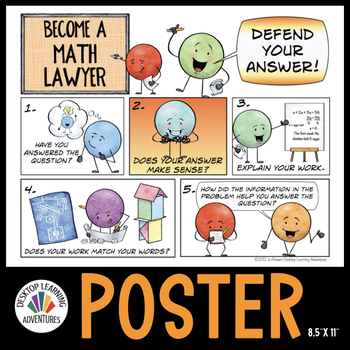- PDF
Description
It's no secret that kids love to role-play. Why not have them become Math Lawyers and defend their answers? As math lawyers, they're given a chance to see their work from another perspective.
Students look at their work differently when they think of it as defending something important. It was fun for me to watch their transformation from students writing numbers on papers to, "I believe in this work, and let me tell you why!"
This poster/label set reminds students that solving a problem is more than just writing down an answer. It gives kids several checkpoints to consider, including, "Does your answer make sense?"
Becoming a math lawyer encourages math conversation. I frequently pair up students to "defend" their answers. It's a great way to have them recheck their work before turning it in.
Not only does it help kids own their work, but it also improves study skills.
The labels make good reminders when attached to their math journals or notebooks.
Download your copy today!
This set includes the Math Lawyer poster, as well as a template for labels that fits Avery Labels 5168, 3.5”x 5".
***************************************************************************
Customer Tips:
How to get TpT credit to use on future purchases:
Please go to your My Purchases page (you may need to login). Beside each purchase you’ll see a Provide Feedback button. Simply click it and you will be taken to a page where you can give a quick rating and leave a short comment for the product. Each time you give feedback, TpT gives you feedback credits that you use to lower the cost of your future purchases. I value your feedback greatly, as it helps me determine which products are most valuable for your classroom, so I can create more for you.
Be the first to know about my new discounts, freebies and product launches:
Look for the green star next to my store logo and click it to become a follower. Voila! You will now receive email updates about this store!
Thanks for stopping by! Pam Kranz
***************************************************************************
© Pamela Kranz Desktop Learning Adventures All Rights Reserved



